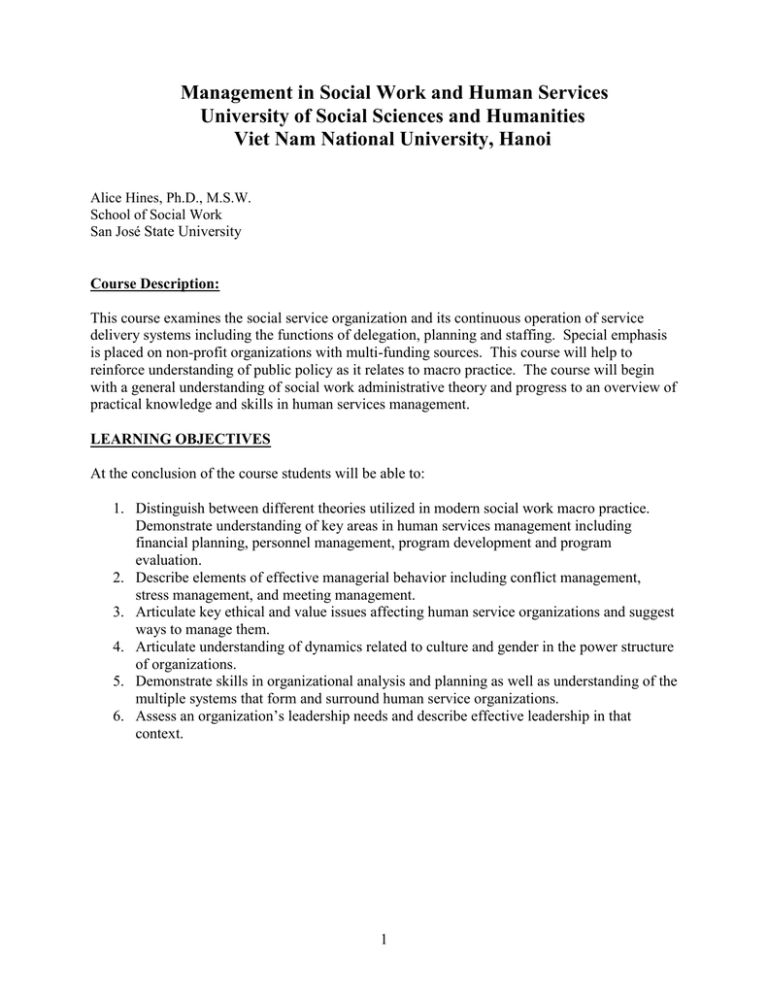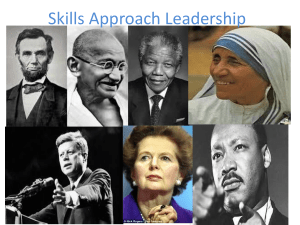Management in Social Work and Human Services
advertisement

Management in Social Work and Human Services University of Social Sciences and Humanities Viet Nam National University, Hanoi Alice Hines, Ph.D., M.S.W. School of Social Work San José State University Course Description: This course examines the social service organization and its continuous operation of service delivery systems including the functions of delegation, planning and staffing. Special emphasis is placed on non-profit organizations with multi-funding sources. This course will help to reinforce understanding of public policy as it relates to macro practice. The course will begin with a general understanding of social work administrative theory and progress to an overview of practical knowledge and skills in human services management. LEARNING OBJECTIVES At the conclusion of the course students will be able to: 1. Distinguish between different theories utilized in modern social work macro practice. Demonstrate understanding of key areas in human services management including financial planning, personnel management, program development and program evaluation. 2. Describe elements of effective managerial behavior including conflict management, stress management, and meeting management. 3. Articulate key ethical and value issues affecting human service organizations and suggest ways to manage them. 4. Articulate understanding of dynamics related to culture and gender in the power structure of organizations. 5. Demonstrate skills in organizational analysis and planning as well as understanding of the multiple systems that form and surround human service organizations. 6. Assess an organization’s leadership needs and describe effective leadership in that context. 1 TEXTBOOKS AND READING ASSIGNMENTS Required Text for the Course: Brody, R. (2005). Effectively managing human service organizations (3rd ed.). Thousand Oaks, CA: Sage Publications. Supplemental readings are designated for each topic below. CLASS TOPICS AND READINGS 1. 7.26.10: Introduction to the Course and Human Services Management Introductions/ student interests/expectations Review of syllabus Discussion of readings and course assignments Introduction to human services management Readings: Denhardt, R. B., Denhardt, J. V., Aristigueta, M. P. (2002).Organizational behavior as a way of thinking and acting. In Managing Human Behavior in Public and Nonprofit Organizations (pp. 1-17). Thousand Oaks, CA: Sage. Overview and Analysis of Theory in Human Service Management Overview of key organizational and management theories Readings: Lewis, J. A., Packard, T. R., & Lewis, M. D. (2007). Organizational theory from human service organizations. In Management of human Service programs (4th, ed., pp. 68-93). Belmont, CA: Thomson Brooks/Cole. Cloke, K, Goldsmith, J. (1997). Brief history of management. In The End of Management and the Rise of Organizational Democracy (pp 20-30). San Francisco: Josey Bass. 2. 7.27.10: Strategic Planning / Program Design and Development Strategic planning Program design and development, including use of logic model in program planning Readings: Brody, Chapters 2, 3 2 3. 7.28.10 Program Implementation and Action Plans Readings: Brody Chapter 4 4. 7.29.10: Problem Solving and Decision Making Governance and decision-making in human service organizations Understanding dynamics of power in organizations Readings: Denhardt, R. B., Denhardt, J. V., Aristigueta, M. P. (2002). Decision making. In Managing human behavior in public and nonprofit organizations (pp. 121-149). Thousand Oaks, CA: Sage. Brody: Chapter 5 5. 7.30.10: Supervision and Fostering a Positive Agency Culture Effective supervision in human service organizations Fostering healthy organizational culture; fostering diversity, preventing personnel problems, and creating a learning organization. Readings: Brody Chapters 9, 10 6. 7.31.10 Interacting and Communicating Effectively Issues in organizational communications with internal and external constituents; public relations; communicating with media Building coalitions; collaborative planning and practice in social services; addressing barriers to effective collaboration and coalition-building Creating and working with teams Readings: Brody Chapters 18, 19 Cloke & Goldsmith, Chapter 12: Building innovative self-management teams. 7. 8.1.10: Human Resource Management Recruitment and retention of employees Conducting effective outreach and interviews Dealing with difficult employees; legal issues; importance of policies and procedures Strategies to support improved job performance Effective performance evaluations Readings: Brody, Chapters, 7, 8, 11 3 8. 8.2.10 Funding and Resource Management Environmental factors impacting fiscal opportunities and constraints in human services Understanding human service budgeting and financial management Overview of funding sources and fundraising options including government, foundation, and private funding sources Strategic resource development; linking fundraising to organizational mission, strategic plans, and community needs Strategies for development of successful proposals Readings: Brody, Chapters 12, 14 9. 8.3.10 Leadership in Human Services Culture and leadership Leadership styles and skills in management of human service organizations Strategies for self-assessment; strategies for obtaining feedback and training for leadership Mentoring emerging leaders in agency and community contexts Readings: Brody Chapter 1 Netting, F., O”Connor, M. (2002) Leadership, critical thinking and self-awareness in organization practice. In Organization practice: A social worker’s guide to understanding human services. Boston: Allyn & Bacon. Chapters on - Culture and Leadership (pp. 301-340); Skills Approach (pp. 39-68); Style Approach (pp. 69-89) In: Northouse, P. (2007) Leadership: Theory and Practice (4th ed.). Thousand Oaks, California: Sage Publications. 10.8.4.10: Course Summary and Review Summary of concepts and content Final exam and course evaluations 4 BIBLIOGRAPHY: Management in Human Services Books: Berman, E.M., Bowma, J.S., West, J.P., & Van Wart, M.R. (2005) Human resource management in public service: Paradoxes, processes, and problems. Thousand Oaks: Sage Publications. Coley, S., & Scheinberg, C. (2000). Proposal writing. Thousand Oaks: Sage Publications. Dym, B.M., & Hutson, H. (2005). Leadership in nonprofit organizations: Lessons from the third sector. Thousand Oaks: Sage Publications. Eliason, M.J. (2007) Improving substance abuse treatment: An introduction to the evidence-based practice movement. Thousand Oaks: Sage Publications. Kettner, P.M., Moroney, R.M., & Martin, L.L. (2007) Designing and managing programs: An effectiveness-based approach. Thousand Oaks: Sage Publications. Manning, S.S. (2003). Ethical leadership in human services: a multi-dimensional approach. Boston: Allyn & Bacon Press. Weinbach, R.W. (2008). Social worker as manager, the: A practical guide to success, 5th edition. South Carolina: Allyn & Bacon Press. Journal Articles & Chapters Hopkins, K. M., & Hyde, C. (2002). The human service managerial dilemma: New expectations, chronic challenges and old solutions. Administration in Social Work, 26(3), 1-15. Johnson, M., & Austin, M. J. (2006). Evidence-based practice in the social services: Implications for organizational change. Administration in Social Work, 30(3), 75-104. Karabanow, J. (2004). Making organizations work: Exploring characteristics of anti-oppressive organizational structures in street youth. Journal of Social Work, 4(1), 47-60 Kluger, M. P. (2006). The program evaluation grid: A planning and assessment tool for nonprofit organizations. Administration in Social Work, 30(1), 33-44. Lonne, B., McDonald, C., & Fox, T. (2004). Ethical practice in the contemporary human services. Journal of Social Work, 4(3), 345-367. Manela, R. W., & Moxley, D. P. (2002). Best practices as agency-based knowledge in social welfare. Administration in Social Work, 26(4), 1-24. Moxley, D. P., & Bueche, L. (2002). Ethical issues in agency resource development: Implications for social administration. Families in Society, 83(3), 265-273. Perlmutter, F. D. (2006). Ensuring social work administration. Administration in Social Work, 30(2), 310. Reilly, T. (2007). Management in local governments: An evolving landscape. Administration in Social Work, 31(2), 49-66. Savaya, R., & Waysman, M. (2005). The Logic Model: A tool for incorporating theory in development and evaluation of programs. Administration in Social Work, 29(2), 85-104. Schmid, H. (2004a). Organization-environment relationships: Theory for management practice in human service organizations. Administration in Social Work, 28(1), 97-113. Schmid, H. (2004b). Organizational and structural dilemmas in nonprofit human service organizations. Administration in Social Work, 28(3/4), 1-221. 5 Tropman, J. E., & Shaefer, H. L. (2004). Flameout at the top-executive calamity in the nonprofit sector: Its Precursors and sequelae. Administration in Social Work, 28(3/4), 161-182. Turner, L. M., & Shera, W. (2005). Empowerment of human service workers: Beyond intraorganizational strategies. Administration in Social Work, 29(3), 79-94. Yoo, J., & Brooks, D. (2005). The role of organizational variables in predicting service effectiveness: An analysis of a multilevel model. Research on Social Work Practice, 15(4), 267-277. 6 7


